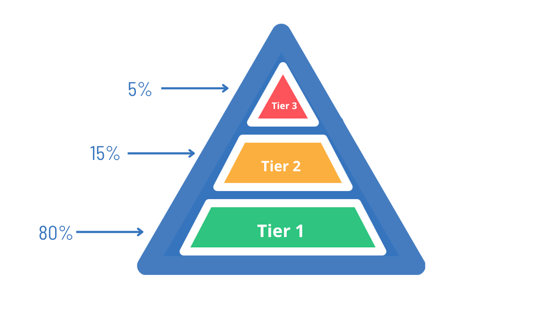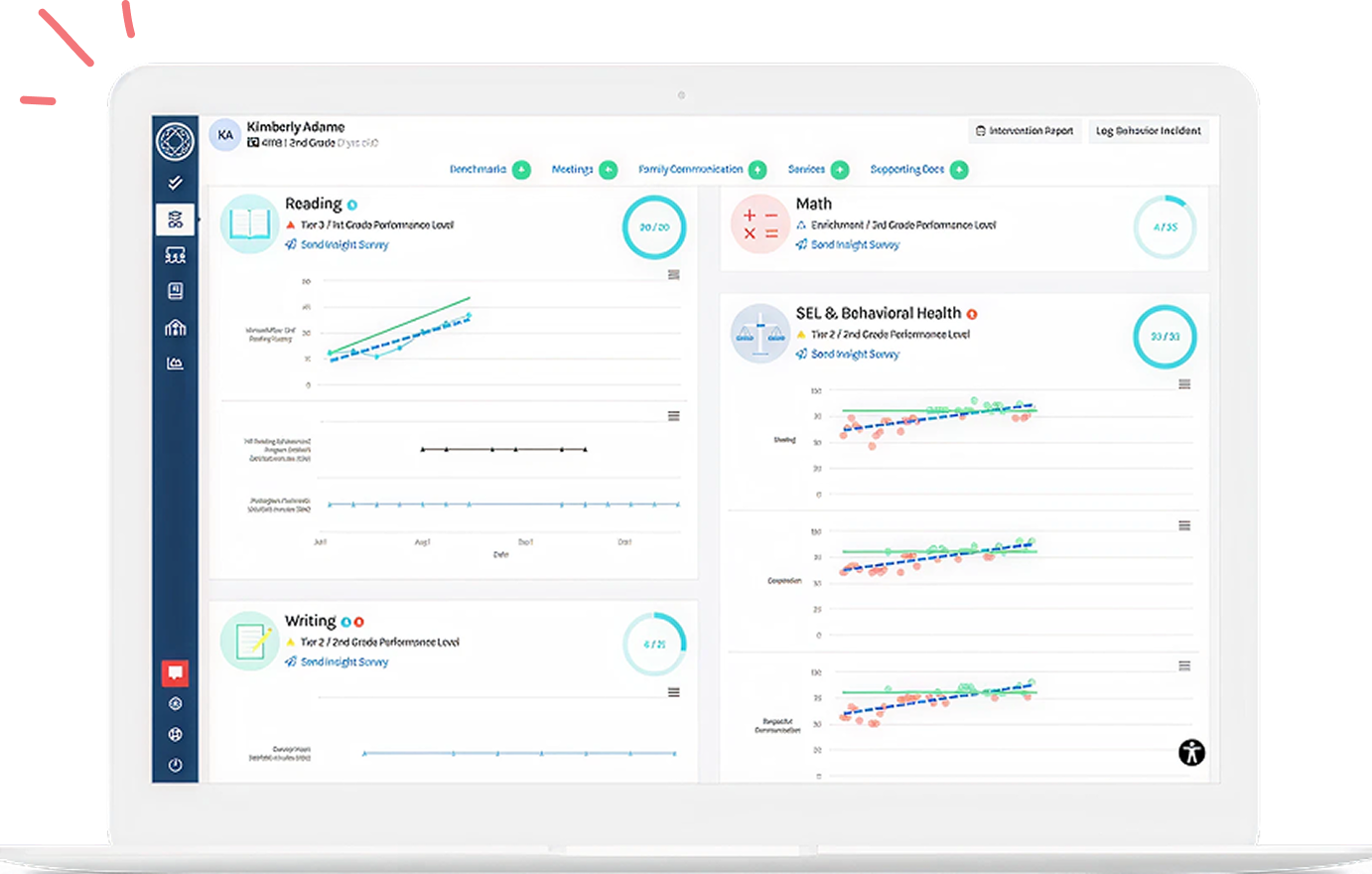Before becoming a professional development consultant with Branching Minds, I spent 34 years in the roles of teacher, interventionist, and instructional specialist; and I’m currently supporting a school district as they continue to improve their MTSS system. My roles allow me to spend time with teachers and administrators from all over the country. And while fall has everyone drinking, eating, and smelling all things pumpkin...for those in education, this season also ushers in a time of data and stress.
Universal Screening
At the beginning, middle, and end of year, scores from universal screening come rolling in. Universal Screeners are a standardized assessment tool to help educators evaluate whether core instruction is effective, and to identify students who need additional support. (Jenkins, Hudson, & Johnson, 2007).
After administering the universal screener to students, we want to see that at least 80% of students are achieving success with core instruction alone and do not need intervention support. This is the measure of an effective Tier 1 core instructional program!
Tier 2 and Tier 3 Supports in MTSS
Approximately 10% to 15% of students perform below their grade-level expectations and require additional Tier 2 instructional intervention beyond the universal classroom instruction all students receive. These students benefit from targeted small group sessions, allowing educators to address specific gaps in understanding and performance. Furthermore, about 5% of students exhibit performance well below their grade level, highlighting a need for Tier 3 individualized intervention. This involves intensive, often one-on-one, tailored instruction designed to meet unique learning needs and to bridge significant educational gaps.

As I collaborate with schools, I OFTEN hear from educators that their MTSS Tier level triangle does not look like the graphic above. In many districts across the country, those perfectly distributed groups are a thing of the past.
In some cases, districts have 50% or more of students falling into the Tier 3 intervention category for academics or behavior, a flipped MTSS triangle! This leaves teachers and administrators alike scrambling to make plans to assist and accelerate student learning to close gaps while maintaining a quality core curriculum.
Flipped MTSS Triangle
After listening to Dr. David Steiner, Director of the Johns Hopkins Institute for Education Policy and Professor of Education at Johns Hopkins University and reading through the Delaware Department of Education Strategy to Accelerate Learning, I was directed to core actions we can take to shift the distribution of students within a tiered system of supports and close student learning gaps.
Your first instinct may be to pull out all these students from the core classroom setting and begin remediating their instruction. WAIT! Read through the following recommendations before rushing into any plan of action.
The DDOE (Delaware Department of Education), along with Dr. David Steiner from Johns Hopkins University, recommends these four core actions:
- 1. High-Quality Instructional Materials (HQIM)
- 2. Ongoing professional development and learning for Tier 1 instruction
- 3. Balanced assessments and data leveraged to diagnose learning needs
- 4. Create support structures to accelerate student learning
These are foundational key understandings that we shouldn’t “assume” all educators know and understand. Let’s take a closer look at each of these core actions for tiered MTSS support.
1. High-Quality Instructional Materials (HQIM)
Dr. Steiner points out that many times, our first reaction regarding instructional materials to address a large number of students performing “below” grade-level expectations is to “dumb down” materials we feel are “too rigorous.” All students should have access to grade-level, high-quality instructional materials and a rigorous curriculum. All students should be held accountable to high standards.
The curriculum should be vetted through sources to cite evidence of effectiveness to maintain those standards. Sites such as What Works Clearinghouse, and Evidence for ESSA are good places for you to determine whether your curriculum meets quality standards. Students must maintain where they are while filling in learning gaps.
➡️ Related Resource: Understanding MTSS Tier Patterns and Movement in MTSS
2. Ongoing Professional Development and Learning for Tier 1 Instruction
A curriculum is only as effective as the instructor. Teachers are always juggling new initiatives and learning. To expect any teacher to know and effectively deliver an HQIM curriculum with one day of professional development is to set both the teacher and student up for failure.
By investing in programs with evidence-based professional development, we can remove another barrier that could keep our underperforming students from success within our HQIM curriculum. Invest the time and resources needed to support teacher excellence with any curriculum/programs delivered on campuses. Your students and teachers deserve every opportunity to excel and succeed.
3. Balanced Assessments That Reveal Student Needs
Having the right data for a data based decision and knowledge to identify learning needs is crucial to shifting the distribution of students with learning tier levels. Through balanced assessments, leaders and teachers can be more aware of large and small learning trends. These assessments also lead to asking tough questions: Do teachers know where students are on key skills?
➡️ Learn more: Universal Screener Assessments vs Summative Assessments vs Progress Monitoring Assessments
Branching Minds cohort report shows how students respond to instruction both relative to each other and as a whole. It also helps teachers identify students with shared needs and allows them to quickly put them into groups and create group plans, send family communications or generate intervention reports, and more.

➡️ Learn more: How to use progress monitoring data to guide decision making in an MTSS practice
4. Structures That Accelerate Learning
Imagine you’re at the airport. You decide to take the moving sidewalk to get to your next flight gate and just leisurely stand while the conveyor moves you along. Next to you is another traveler who, in addition to being on the conveyor, supplements this wonderful means of transportation by walking as usual.
Who will reach the goal destination first? You guessed it—the traveler who utilizes the provided means of transportation while adding additional support to move more quickly to the next destination.
In terms of learning acceleration, this means in addition to an HQIM curriculum; schools are supplementing with: high impact tutoring; acceleration academies; summer learning programs; students are on the Tier 1 instructional conveyor AND in addition, they are “walking” to “supplement” their progress. Makes sense...right?
➡️ Learn more: Recharging Core Instruction and MTSS
The Branching Minds Tier Movement Report shows students’ movement within the Tier framework from one assessment window to the next. You can quickly see in dynamic real-time reports if progress is being made toward a more acceptable distribution of students and gauge whether Tier 1 instruction is meeting the needs of students.
.png?width=700&height=433&name=Macbook_TierMovementReport%20(2).png)
MTSS Plan of Action
We cannot afford to continue with outdated approaches in response to the overwhelming needs of our students who are performing below expectations. Let’s make a plan of action for your MTSS system:
- Analyze your curriculum and make sure you are delivering high-quality, data-driven instruction that is rigorous and standards-based.
- Seek out professional development, whether by requesting this from a company, watching a webinar series, or reading blog articles. Be proactive in your learning.
- Make sure you utilize the assessments available to find trends, gaps, and needs for your students.
- Supplement your core curriculum with acceleration and get your students on a quicker path to achieve grade-level success.
Be strategic and make the hard but important educational decisions to shift your MTSS tiers right-side-up!
Learning More About Branching MindsBranching Minds is an MTSS/RTI system-level education platform that brings together innovative, easy-to-use technology with the latest insights from the learning sciences to help drive student and school success while making teachers and administrators work easier and more effectively. Branching Minds connects data, systems, interventions, and stakeholders so that educators, administrators, and families can work better together to support students' holistic needs.
|
Resources:
https://edpolicy.education.jhu.edu/author/the_institute/
Accelerated Learning Presentation by Dr. David Steiner for the Delaware Department of Education
Jenkins, J. R., Hudson, R. F., & Johnson, E. S. (2007). Screening for at-risk readers in a response to intervention framework. School Psychology Review, 36, 582–600.

About the author
Sandra Spruell
Sandra Spruell is an experienced educator and educational consultant with a strong background in curriculum development, instructional leadership, and intervention strategies. As an Educational Consultant at Branching Minds, Sandra has held various leadership roles. With over three decades in public education, she has taught multiple grade levels and contributed to districtwide initiatives in curriculum design, teacher mentorship, and professional development. Holding a master’s in educational leadership and multiple certifications, Sandra is dedicated to improving student outcomes and supporting educators.

Your MTSS Transformation Starts Here
Enhance your MTSS process. Book a Branching Minds demo today.

















.png?width=716&height=522&name=Tech-Learning-Most-Influential-Edtech-Product-2025(preview).png)
.png?width=716&height=522&name=MTSS-interventions-secondary-school(preview).png)